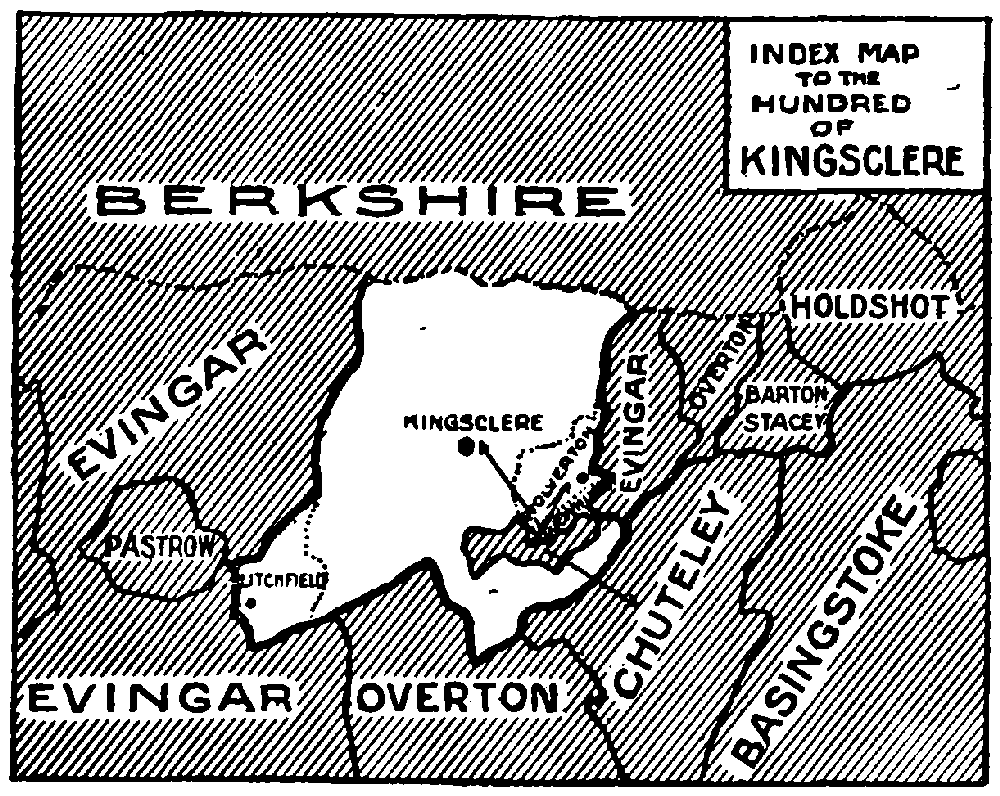A History of the County of Hampshire: Volume 4. Originally published by Victoria County History, London, 1911.
This free content was digitised by double rekeying. All rights reserved.
'The hundred of Kingsclere', in A History of the County of Hampshire: Volume 4, ed. William Page (London, 1911), British History Online https://prod.british-history.ac.uk/vch/hants/vol4/pp245-246 [accessed 23 April 2025].
'The hundred of Kingsclere', in A History of the County of Hampshire: Volume 4. Edited by William Page (London, 1911), British History Online, accessed April 23, 2025, https://prod.british-history.ac.uk/vch/hants/vol4/pp245-246.
"The hundred of Kingsclere". A History of the County of Hampshire: Volume 4. Ed. William Page (London, 1911), British History Online. Web. 23 April 2025. https://prod.british-history.ac.uk/vch/hants/vol4/pp245-246.
THE HUNDRED OF KINGSCLERE
containing the parishes of Ewhurst; Kingsclere (fn. 1) (part of); Litchfield; Wolverton
The above list represents the extent of the hundred at the time of the Population Returns of 1831. (fn. 2) At the time of the Domesday Survey the hundred of Kingsclere comprised Ewhurst, (fn. 3) Wolverton, (fn. 4) Ecchinswell, (fn. 5) Sydmonton, (fn. 6) the tithing of Swampton in St. Mary Bourne, (fn. 7) the tithing of Earlstone in the parish of Burghclere, (fn. 8) and the whole of the modern parish of Kingsclere, (fn. 9) with the exception of the tithings of Kingsclere Lordship and Kingsclere Parsonage and a small estate called Tidgrove in the tithing of North Oakley. Kingsclere Lordship was entered under Basingstoke Hundred (fn. 10) and Kingsclere Parsonage under Mainsbridge Hundred, (fn. 11) while Tidgrove and a portion of Litchfield formed part of the hundreds of Redbridge (fn. 12) and Pastrow (fn. 13) respectively. The land comprising the hundred was assessed at a little over 30 hides. By 1346 the hundred had assumed practically the same dimensions as in 1831, comprising as it did the modern parishes of Ewhurst, Kingsclere, Sydmonton (fn. 14) and Wolverton, the greater part of Litchfield and the tithing of Earlstone in the parish of Burghclere. (fn. 15) The rest of Litchfield, as in 1086, was still in Pastrow Hundred, (fn. 16) but how much longer it remained so is unknown. (fn. 17) Ecchinswell, as part of the liberty of the Bishop of Winchester, was included in Evingar Hundred (fn. 18) and is so still, and Swampton also before 1346 had been transferred to the same hundred. (fn. 19)

Index Map to the Hundred of Kingsclere
Since 1831 the tithing of Earlstone has been transferred to the hundred of Evingar, and the hundred of Kingsclere now consists of the parishes of Ewhurst, Kingsclere, Litchfield, Sydmonton (constituted a separate parish in 1852) and Wolverton.
As its name implies, Kingsclere Hundred formerly belonged to the Crown. The grant of the manor of Kingsclere to the church of St. Mary, Rouen, was followed by the grant of the hundred, the grantor being probably King Henry II, and his charter was confirmed by King John and by King Henry III in 1227. (fn. 20) By 1280, however, the hundred had once more become Crown property, (fn. 21) and it is probable that during the reigns of Edward I and Edward II the king held one hundred court only for the vills comprising the hundreds of Pastrow and Kingsclere. (fn. 22) The hundred was perhaps included in the sale of Kingsclere Manor to William de Melton, Archbishop of York, in 1335, although it is not specifically mentioned. It was sold, however, with the manor in 1544 to Sir William Paulet by Sir George Darcy and Dorothy his wife, daughter and heir of Sir John Melton, (fn. 23) and from this time it has followed the same descent as the manor (q.v.).
The hundred court was held in the open air on Nothing Hill, (fn. 24) near Frobury. (fn. 25)